| |
SWIFTS Apodidae |
- 93 species worldwide
- DR personal total: 72 species (77%), 12 photos
|
 Swifts
are the most aerial of birds. Dashing across the skies on scythe-like
wings, they are difficult to study, let alone photograph. It has taken
me years to get a decent shot of my local resident species, White-throated Swift
(left). This dramatically patterned species has a far-carrying
chattering call that usually announces its presence high overhead long
before one is likely to spot it. In spring, pair engage in the most
exhilarating of chases across the sky and when in copulation, they
tumble together towards earth in a free-fall, breaking apart just short
of impact to veer back up into the wild blue yonder. Swifts
are the most aerial of birds. Dashing across the skies on scythe-like
wings, they are difficult to study, let alone photograph. It has taken
me years to get a decent shot of my local resident species, White-throated Swift
(left). This dramatically patterned species has a far-carrying
chattering call that usually announces its presence high overhead long
before one is likely to spot it. In spring, pair engage in the most
exhilarating of chases across the sky and when in copulation, they
tumble together towards earth in a free-fall, breaking apart just short
of impact to veer back up into the wild blue yonder.
If
your reincarnation fantasy is to come back as bird – because they can
fly – then your greatest wish would be to reappear as a swift. |
 One
aspect that I find fascinating is the breeding
ecology of those swifts that nest behind waterfalls or within
inaccessible sea caves. Here in the western United States, that
specialist is Black Swift (right, in a great shot by Ron Branson). One
aspect that I find fascinating is the breeding
ecology of those swifts that nest behind waterfalls or within
inaccessible sea caves. Here in the western United States, that
specialist is Black Swift (right, in a great shot by Ron Branson).
Black Swift breeds locally from Alaska
to Costa Rica, and in the West Indes, but only behind waterfalls
inland, or on perpendicular sea-cliffs in central California. This
latter habitat provided the backdrop for Branson's photo from Santa
Cruz, California (right). It pastes together lichen and moss in a small crevice, and there
the female lies a single egg. Both adults feed the nestling until it is
bigger than they are, until it fledges and flies. All of them, adults
and young, immediately depart for the long flight to South America,
where almost nothing is known about their winter behavior. |
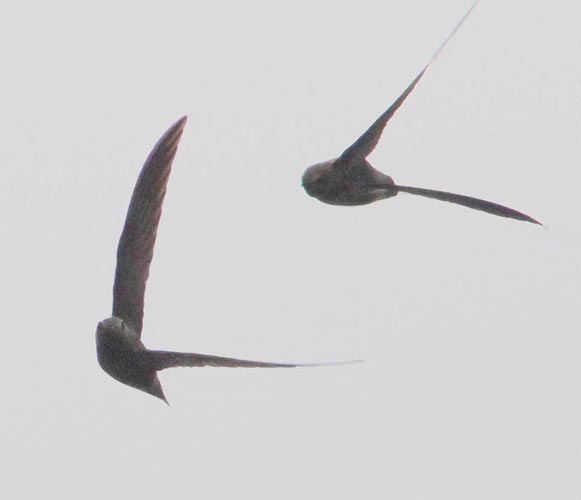 I
became concerned about local Monterey–Santa Cruz populations of Black
Swift when many known sites became unoccupied in the 1990s. A survey of
all Santa Cruz sites, organized by David Suddjian in 2002 & 2004,
found no breeding swifts. Declines were also noted in Monterey County,
although small numbers persist. These two Black Swift (left) were interacting near their sea-cave colony at Rocky Pt. in Monterey County. I
became concerned about local Monterey–Santa Cruz populations of Black
Swift when many known sites became unoccupied in the 1990s. A survey of
all Santa Cruz sites, organized by David Suddjian in 2002 & 2004,
found no breeding swifts. Declines were also noted in Monterey County,
although small numbers persist. These two Black Swift (left) were interacting near their sea-cave colony at Rocky Pt. in Monterey County.
What could cause these
declines? All the nest sites were well-protected; many are in State
parks or Federal wilderness. I researched this question in writing the
species account (Roberson & Collins 2008) in the current account of California Bird Species of Special Concern. I learned that
Black Swifts almost exclusively feed their young flying ants. If the
coastal California populations feeds entirely on the patchy and
unpredictable swarms of these winged ants, it may be declines in ant
populations that threaten our breeding swifts. Flying ants could be
affected by pesticides or exotic ants, but little is known about them.
The interrelation of birds and their prey is incredibly important — and
it is something that we known almost nothing about for this wonderful
species. |
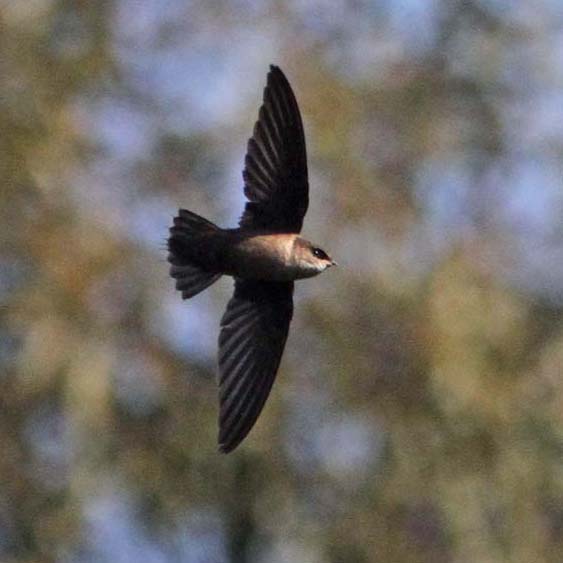 Most
swifts are smaller birds and less patterned than the ones discussed
above. These plain swifts include ten species in the widespread New
World genus Chaetura. About half of these small species are highly migratory, including the local western North American breeding species Vaux's Swift
(right). One rarely gets this close a view of these constantly-moving
'flying cigars.' You might even see the tiny feet in this shot. Those
feet have strong claws for hanging onto tiny cracks in vertical
surfaces, but do little else. Indeed, the Greek words that are the root
of the formal family name Apodidae are a-pous, meaning "without foot" (Chantler 1999). Most
swifts are smaller birds and less patterned than the ones discussed
above. These plain swifts include ten species in the widespread New
World genus Chaetura. About half of these small species are highly migratory, including the local western North American breeding species Vaux's Swift
(right). One rarely gets this close a view of these constantly-moving
'flying cigars.' You might even see the tiny feet in this shot. Those
feet have strong claws for hanging onto tiny cracks in vertical
surfaces, but do little else. Indeed, the Greek words that are the root
of the formal family name Apodidae are a-pous, meaning "without foot" (Chantler 1999).
Vaux's
Swift typically nests in large hollow trees, like burned-out redwoods
or douglas-firs, entering the cavity via holes made by large
woodpeckers, and especially Pileated Woodpecker Drycopus pileatus
(Sterling & Paton 1996). They glue their nest on the inside of the
vertical surface. Recently, though, many have adapted to nesting in
chimneys in northwestern California (Hunter et al. 2005). This
adaptation was adopted centuries ago by the eastern species of Chaetura, the Chimney Swift C. pelagica. |
 Species
limits in Neotropical species continue to be refined. Only within this
decade has the population of small swifts in southern Central America,
traditionally considered a subspecies of Band-rumped Swift C. spinicauda, been considered a separate species (Marín 2000). Now called Costa Rican Swift (right), it was common over the Osa Peninsula of the Pacific lowlands of southern Costa Rica, and ranges south to Colombia. Species
limits in Neotropical species continue to be refined. Only within this
decade has the population of small swifts in southern Central America,
traditionally considered a subspecies of Band-rumped Swift C. spinicauda, been considered a separate species (Marín 2000). Now called Costa Rican Swift (right), it was common over the Osa Peninsula of the Pacific lowlands of southern Costa Rica, and ranges south to Colombia.
Field identification of Chaetura
swifts is difficult, and one most focus on the relative paleness of the
rump and throat, accurately evaluate size, or learn the distinctive
differences in vocalizations. This is particularly true with vagrants.
Chimney Swift now appears sporadically in summer in California, and has
nested at some locales (sometimes in fair numbers), but must always be
careful identified. |
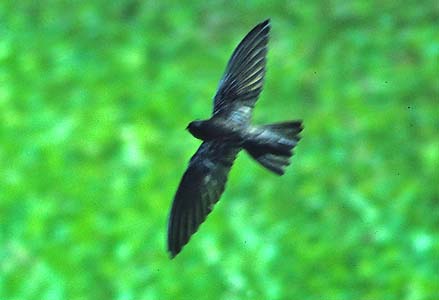 In the Old World, the 25 or so species of Aerodramus & Collocalia
swiftlets, scattered from India to Australasia, and out onto the
islands of the Indian and South Pacific oceans, are an even more
intractable field problem. Most identifications rely heavily on range. Caroline Swiftlet
(left) occurs only in the Caroline Islands (Chuuk, Pohnpei, Kosrae) of
Micronesia. There are unresolved taxonomic issues related to how many
species there are, especially among the swiftlets of the Philippines,
Borneo, and New Guinea, and there may even by undescribed species in
the mountains of these remote islands. In the Old World, the 25 or so species of Aerodramus & Collocalia
swiftlets, scattered from India to Australasia, and out onto the
islands of the Indian and South Pacific oceans, are an even more
intractable field problem. Most identifications rely heavily on range. Caroline Swiftlet
(left) occurs only in the Caroline Islands (Chuuk, Pohnpei, Kosrae) of
Micronesia. There are unresolved taxonomic issues related to how many
species there are, especially among the swiftlets of the Philippines,
Borneo, and New Guinea, and there may even by undescribed species in
the mountains of these remote islands.
One set of species — Edible-nest Swiftlet A. fuciphagus, Black-nest Swiftlet A. maximus, and Mossy-nest Swiftlet A. salangana
— is best separated by the color and material composition of their
nests, pasted together at the entrances of caves. Swiftlets can be
abundant over Borneo's Kinabatangan River, for example, but separating
them in the field seems nearly impossible. Fortunately they all nest in
nearby Gomantong Cave. There, Black-nest is most abundant. If the same
levels of abundance applies to swiftlets over the river, one could make
tentative field identifications there on subtle differences in size,
using the appearance of the most common species to represent Black-nest
and working from that. The collection of nests of the species which
build edible nests (including A. fuciphagus) — the nests are
considered a delicacy in some Asian cuisines — has caused significant
declines in these species. Over 20 million nests are consumed in one
year in Hong Kong alone (Chantler 1999). |
Shape differences can be important field characters. Compare the shape of these two small swifts in the Philippines: the Aerodramus — Philippine Swift (below left) — is the routine 'cigar on wings' while Philippine Spinetail (below right), in the genus Mearnsia, has a strongly bat-like profile. |
|
|
|
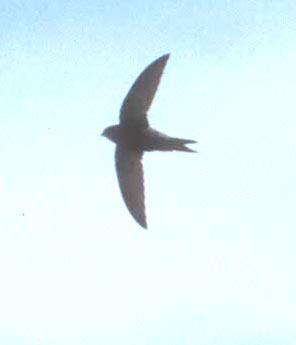 In the Old World, Apus is a widespread and common genus across Eurasia and Africa. Common Swift
(right) is the most widespread of all, breeding from England to China
(this photo was taken near the eastern edge of its range) and then
migrating well south to winter in southern Africa. Although there are
very common Apus swifts, others among the 15 species in the genus are rare and local, such as Forbes-Watson's Swift A. berliozi, breeding only in Somalia and on Socotra islands. In the Old World, Apus is a widespread and common genus across Eurasia and Africa. Common Swift
(right) is the most widespread of all, breeding from England to China
(this photo was taken near the eastern edge of its range) and then
migrating well south to winter in southern Africa. Although there are
very common Apus swifts, others among the 15 species in the genus are rare and local, such as Forbes-Watson's Swift A. berliozi, breeding only in Somalia and on Socotra islands.
There
is some evidence that the smaller species are generalists on aerial
insects, taking a wide variety of flying prey, because their foraging
range is restricted. Larger species are able to range farther during a
day's foraging, and can specialize on specific and patchy resources.
Swifts can distinguish between flying prey and avoid those with
stingers; Chantler (1999) cites studies on wintering Common Swifts in
Zaire that showed they took only stingless honeybee drones when
foraging around hives. |
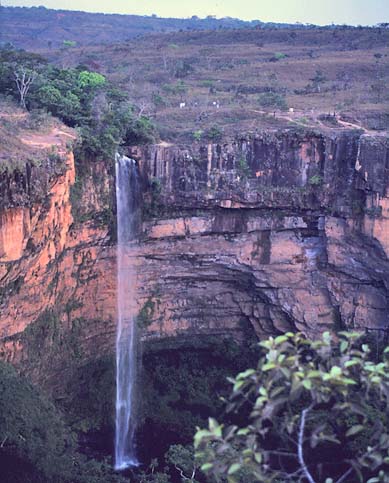 Some of the most impressive swifts in the world are those that breed only behind waterfalls. An impressive
colony of Great Dusky Swift Cypseloides senex roost and breed
in the spray zone of this 400m (1300') waterfall in Chapada dos
Guimarães, Brazil (left). Another favored waterfall is
Iguazú Falls on the border of Brazil and Argentina; some
spectacular photos of the roosts there are in Chandler (1999). As the
bird forage throughout the day, one must often be at such site at dawn
or dusk to see them depart or return. Mid-day visits net no swifts. Some of the most impressive swifts in the world are those that breed only behind waterfalls. An impressive
colony of Great Dusky Swift Cypseloides senex roost and breed
in the spray zone of this 400m (1300') waterfall in Chapada dos
Guimarães, Brazil (left). Another favored waterfall is
Iguazú Falls on the border of Brazil and Argentina; some
spectacular photos of the roosts there are in Chandler (1999). As the
bird forage throughout the day, one must often be at such site at dawn
or dusk to see them depart or return. Mid-day visits net no swifts.
Waterfall Swift Hydrochous gigas
of montane Malaya, plus Sumatra and Java, is also confined as a breeder
to this restricted, and highly protected, niche habitat. On a tour of
Java with Ben King back in 1998, our group had to arise at 3 a.m. to
begin the trek through Gede National Park to reach the waterfall at
dawn — the only chance we would have to see those unique swifts.
There
are still many interesting swifts to see, and we are only beginning to
learn details of swift ecology, echolocation ability, and taxonomy. |
| |
Photos: The White-throated Swift Aeronautes saxatalis was at Salinas, California, on 26 May 2008. Ronald L. Branson photographed the Black Swift Cypseloides niger
at Santa Cruz, California, in July 1971; my photo of two Black Swifts
is near their sea cave at Rocky Pt., Monterey Co., California, on 6 Aug
2011. The Vaux's Swift Chaetura vauxi was at Big Sur R. mouth, Monterey Co., California, on 25 May 2008. The Costa Rican Swift Chaetura fumosa was at Rio del Tigre, Osa Peninsula, Costa Rica, on 27 Dec 2007. The Caroline Swiftlet Aerodramus inquieta was on Moen I., Chuuk (formerly Truk), Micronesia, on 30 Aug 1978. The Philippine Swiftlet Aerodramus mearnsi was at Mt. Polis, Luzon, Philippines, on 1 Jan 2006, and the Philippine Needletail Mearnsia picina was over the PICOP forest of s.e. Mindanao, Philippines, on 26 Dec 2005. The Common Swift Apus apus was near Qinghai Lake, China, on 18 June 2004. I photographed the
waterfall at Chapada dos Guimarães, Brazil, in August 1999. All photos © Don Roberson except the Black Swift © Ronald L. Branson, and used with permission; all rights reserved.
Bibliographic note:
Family book: 
Chantler, P. 1998. Swifts: A Guide to the Swifts and Treeswifts of the World. 2nd ed. Yale Univ. Press, New Haven, CT.
The
second edition of this family volume was published in the U.K. by Pica
Press, but in the U.S. by Yale. It is in the standard format of whole
series of Pica Press family guides, with color plates found separately
(with facing page captions) from the text, giving the feeling this is
meant to be a field guide. The paintings are by Gerald Driessens, who
was listed as a co-author of the first edition but that co-authorship
was dropped without explanation in this second edition. Some of the
plates of swifts are okay, and one was significantly upgraded in the
second edition, but overall they were underwhelming.
My detailed review of this 2nd edition of Swifts appeared in Auk
118:274-277 (2001), and I considered the Apodidae text in some detail.
Short version of my review: the book is pretty good for Old World
species (but there are exceptions), very uneven on South American
species, and inexcusably poor on North American species. My full review
is available via pdf on-line.
The family is now well-covered by Phil Chantler, who authored the Pica Press book, in the Handbook of the Birds of the World
series (Chantler 1999). In some respects the color plates were improved
over the Driessens' pages in HBW. There is an extensive family text and
some great color photos. For this family, I think that the HBW chapter
is superior to the Pica Press book, except, perhaps, for the greater
attention to subspecies in Chantler (1998).
Literature cited:
Chantler, P. 1999. Family Apodidae (Swifts), pp. 388 –457 in Handbook of the Birds of the World (del Hoyo, J., A. Elliott & J. Sargatal, eds). Vol. 5. Lynx Edicions, Barcelona, Spain.
Hunter,
J.E., D. Fix, G.A. Schmidt, and J.C. Power. 2005. Atlas of the Breeding
Birds of Humboldt County, California. Redwood Region Audubon Soc.,
Eureka, CA.
Maríin, M. 2000. Species limits,
distribution, and biogeography of some New World gray-rumped
spine-tailed swifts (Chaetura, Apodidae). Ornitologia Neotropical 11:
93-108.
Roberson, D., and C. Collins. "Black Swift," pp. 250-253 in
California Bird Species of Special Concern (W.D. Shuford & T.
Gardali, eds.). Studies of Western Birds 1. Western Field
Ornithologists, Camarillo, CA, and Calif. Dept. Fish & Game,
Sacramento, CA.
Sterling, J., and W.C. Paton. 1996. Breeding distribution of Vaux's Swift in California. West. Birds 27: 30–40.
|
|
|

 Swifts
are the most aerial of birds. Dashing across the skies on scythe-like
wings, they are difficult to study, let alone photograph. It has taken
me years to get a decent shot of my local resident species, White-throated Swift
(left). This dramatically patterned species has a far-carrying
chattering call that usually announces its presence high overhead long
before one is likely to spot it. In spring, pair engage in the most
exhilarating of chases across the sky and when in copulation, they
tumble together towards earth in a free-fall, breaking apart just short
of impact to veer back up into the wild blue yonder.
Swifts
are the most aerial of birds. Dashing across the skies on scythe-like
wings, they are difficult to study, let alone photograph. It has taken
me years to get a decent shot of my local resident species, White-throated Swift
(left). This dramatically patterned species has a far-carrying
chattering call that usually announces its presence high overhead long
before one is likely to spot it. In spring, pair engage in the most
exhilarating of chases across the sky and when in copulation, they
tumble together towards earth in a free-fall, breaking apart just short
of impact to veer back up into the wild blue yonder. One
aspect that I find fascinating is the breeding
ecology of those swifts that nest behind waterfalls or within
inaccessible sea caves. Here in the western United States, that
specialist is Black Swift (right, in a great shot by Ron Branson).
One
aspect that I find fascinating is the breeding
ecology of those swifts that nest behind waterfalls or within
inaccessible sea caves. Here in the western United States, that
specialist is Black Swift (right, in a great shot by Ron Branson).  I
became concerned about local Monterey–Santa Cruz populations of Black
Swift when many known sites became unoccupied in the 1990s. A survey of
all Santa Cruz sites, organized by David Suddjian in 2002 & 2004,
found no breeding swifts. Declines were also noted in Monterey County,
although small numbers persist. These two Black Swift (left) were interacting near their sea-cave colony at Rocky Pt. in Monterey County.
I
became concerned about local Monterey–Santa Cruz populations of Black
Swift when many known sites became unoccupied in the 1990s. A survey of
all Santa Cruz sites, organized by David Suddjian in 2002 & 2004,
found no breeding swifts. Declines were also noted in Monterey County,
although small numbers persist. These two Black Swift (left) were interacting near their sea-cave colony at Rocky Pt. in Monterey County.  Most
swifts are smaller birds and less patterned than the ones discussed
above. These plain swifts include ten species in the widespread New
World genus Chaetura. About half of these small species are highly migratory, including the local western North American breeding species Vaux's Swift
(right). One rarely gets this close a view of these constantly-moving
'flying cigars.' You might even see the tiny feet in this shot. Those
feet have strong claws for hanging onto tiny cracks in vertical
surfaces, but do little else. Indeed, the Greek words that are the root
of the formal family name Apodidae are a-pous, meaning "without foot" (Chantler 1999).
Most
swifts are smaller birds and less patterned than the ones discussed
above. These plain swifts include ten species in the widespread New
World genus Chaetura. About half of these small species are highly migratory, including the local western North American breeding species Vaux's Swift
(right). One rarely gets this close a view of these constantly-moving
'flying cigars.' You might even see the tiny feet in this shot. Those
feet have strong claws for hanging onto tiny cracks in vertical
surfaces, but do little else. Indeed, the Greek words that are the root
of the formal family name Apodidae are a-pous, meaning "without foot" (Chantler 1999).  Species
limits in Neotropical species continue to be refined. Only within this
decade has the population of small swifts in southern Central America,
traditionally considered a subspecies of Band-rumped Swift C. spinicauda, been considered a separate species (Marín 2000). Now called Costa Rican Swift (right), it was common over the Osa Peninsula of the Pacific lowlands of southern Costa Rica, and ranges south to Colombia.
Species
limits in Neotropical species continue to be refined. Only within this
decade has the population of small swifts in southern Central America,
traditionally considered a subspecies of Band-rumped Swift C. spinicauda, been considered a separate species (Marín 2000). Now called Costa Rican Swift (right), it was common over the Osa Peninsula of the Pacific lowlands of southern Costa Rica, and ranges south to Colombia.  In the Old World, the 25 or so species of Aerodramus & Collocalia
swiftlets, scattered from India to Australasia, and out onto the
islands of the Indian and South Pacific oceans, are an even more
intractable field problem. Most identifications rely heavily on range. Caroline Swiftlet
(left) occurs only in the Caroline Islands (Chuuk, Pohnpei, Kosrae) of
Micronesia. There are unresolved taxonomic issues related to how many
species there are, especially among the swiftlets of the Philippines,
Borneo, and New Guinea, and there may even by undescribed species in
the mountains of these remote islands.
In the Old World, the 25 or so species of Aerodramus & Collocalia
swiftlets, scattered from India to Australasia, and out onto the
islands of the Indian and South Pacific oceans, are an even more
intractable field problem. Most identifications rely heavily on range. Caroline Swiftlet
(left) occurs only in the Caroline Islands (Chuuk, Pohnpei, Kosrae) of
Micronesia. There are unresolved taxonomic issues related to how many
species there are, especially among the swiftlets of the Philippines,
Borneo, and New Guinea, and there may even by undescribed species in
the mountains of these remote islands. 
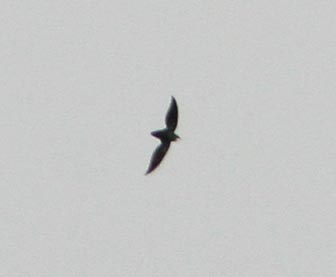
 In the Old World, Apus is a widespread and common genus across Eurasia and Africa. Common Swift
(right) is the most widespread of all, breeding from England to China
(this photo was taken near the eastern edge of its range) and then
migrating well south to winter in southern Africa. Although there are
very common Apus swifts, others among the 15 species in the genus are rare and local, such as Forbes-Watson's Swift A. berliozi, breeding only in Somalia and on Socotra islands.
In the Old World, Apus is a widespread and common genus across Eurasia and Africa. Common Swift
(right) is the most widespread of all, breeding from England to China
(this photo was taken near the eastern edge of its range) and then
migrating well south to winter in southern Africa. Although there are
very common Apus swifts, others among the 15 species in the genus are rare and local, such as Forbes-Watson's Swift A. berliozi, breeding only in Somalia and on Socotra islands.  Some of the most impressive swifts in the world are those that breed only behind waterfalls. An impressive
colony of Great Dusky Swift Cypseloides senex roost and breed
in the spray zone of this 400m (1300') waterfall in Chapada dos
Guimarães, Brazil (left). Another favored waterfall is
Iguazú Falls on the border of Brazil and Argentina; some
spectacular photos of the roosts there are in Chandler (1999). As the
bird forage throughout the day, one must often be at such site at dawn
or dusk to see them depart or return. Mid-day visits net no swifts.
Some of the most impressive swifts in the world are those that breed only behind waterfalls. An impressive
colony of Great Dusky Swift Cypseloides senex roost and breed
in the spray zone of this 400m (1300') waterfall in Chapada dos
Guimarães, Brazil (left). Another favored waterfall is
Iguazú Falls on the border of Brazil and Argentina; some
spectacular photos of the roosts there are in Chandler (1999). As the
bird forage throughout the day, one must often be at such site at dawn
or dusk to see them depart or return. Mid-day visits net no swifts. 